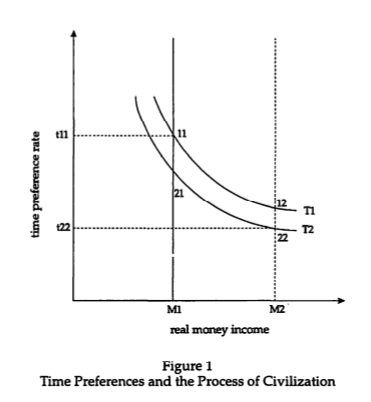Time preference - what is it and why is it important #1
Time preference - what is it and why is it important
When we act in any way, we aim to substitute our current state for a more satisfactory state of affairs. We demonstrate some kind of preference for more rather than fewer goods. Also, we consider when in the future our goals will be reached, that is, the time necessary to accomplish them, as well as a good's duration of serviceability. We also demonstrate a preference for earlier over later goods, and for more over less durable ones. This is phenomenon is called time preference.
We know that time is scarce, so present or earlier goods are and must invariably be, valued more highly than future or later ones. Imagine if we were not constrained by time preference and the only thing that we are considered with is having more over less. In that case, we would always choose a production process which yielded the larges output per unit of input, no matter the time needed for these methods to bear fruit. If you happen to be stranded on an island, for example, building a fishing boat probably would not be the first thing you would do. Instead of a fishing boat, you would probably make a simple fishing net - because you get hungry pretty fast, you can build a fishing boat later. It is evident that man cannot but "value fractions of time of the same length in a different way according as they are nearer or remoter from the instant of the actor's decision".
When we are constrained by time preference, we will only exchange a present good for a future one if we anticipate thereby increasing out the amount of future goods. The rate of time preference, which is different from person to person and from one point in time to the next, but which can never be anything but positive for everyone. Time preference determines the height of the premium which present goods command over future ones as well as the amount of savings and investment. The market rate o interest is the aggregate sum of all individual time-preference rates reflecting the social rate of time preference and equilibrating social savings (i.e., the supply of present goods offered for exchange against future goods) and social investment (i.e, the demand for present goods thought capable of yielding future returns).
For example, there would be no point in loans if there was no time preference. Firstly, no supply of loanable funds can exist without previous savings, i.e, without abstaining from a possible consumption of present goods (an excess of current productions over current consumption), also there would be no demand for them because no one would perceive any opportunity to employ present goods productively, i.e., to invest them so as to produce a future output that would exceed current input. If there is no time preference, if all present goods were consumed and none invested in time-consuming production methods,the interest rate would go to infinity which, anywhere outside of the Garden of Eden, would be tantamount to leading a mere animal existence, i.e., we would live like animals - facing reality with nothing but our bare hands and desire for instant gratification.
A supply of and a demand for loanable funds only arise-and this is the human condition-if it is recognized first that indirect (more roundabout, lengthier) production processes yield a larger or better output per input than direct and short ones. Second, it must be possible, by means of savings, to accumulate the amount of present (consumption) goods needed to provide for all those wants whose satisfaction during the prolonged waiting time is deemed more urgent than the increment in future well-being expected from the adoption of a more time-consuming production process.
As longs as these conditions are met, capital formation and accumulation will set in and continue. Land and labor (the originary factors of production), instead of being supported by and engaged in instantaneously gratifying production processes, are supported by an excess of production over consumption and employed in the production of capital goods. Capital goods have no value except as intermediate products in the process of turning out final (consumer) goods later, and insofar as the production of final products is more productive with than without them, or, what amounts to the same thing, insofar as he who possesses and can produce with the aid of capital goods in nearer in time to the completion of his ultimate goal than he who must do without them.
The lower the time-preference rate, the earlier the onset of the process of capital formation, and the faster the roundabout structure of production will be lengthened. Any increase in the accumulation of capital goods and the roundaboutness of the production structure in turn raises the marginal productivity of labor. This leads to either increased employment or wage rates, or even if the labor supply curve should become backward sloping with increased wage rates, to a higher wage total. Supplied with an increased amount of capital goods, a better paid population of wage earners will produce an overall increased-future-social product, thus also raising the real incomes of the owners of capital and land.


Congratulations! This post has been upvoted from the communal account, @minnowsupport, by nullpointer from the Minnow Support Project. It's a witness project run by aggroed, ausbitbank, teamsteem, someguy123, neoxian, followbtcnews, and netuoso. The goal is to help Steemit grow by supporting Minnows. Please find us at the Peace, Abundance, and Liberty Network (PALnet) Discord Channel. It's a completely public and open space to all members of the Steemit community who voluntarily choose to be there.
If you would like to delegate to the Minnow Support Project you can do so by clicking on the following links: 50SP, 100SP, 250SP, 500SP, 1000SP, 5000SP.
Be sure to leave at least 50SP undelegated on your account.